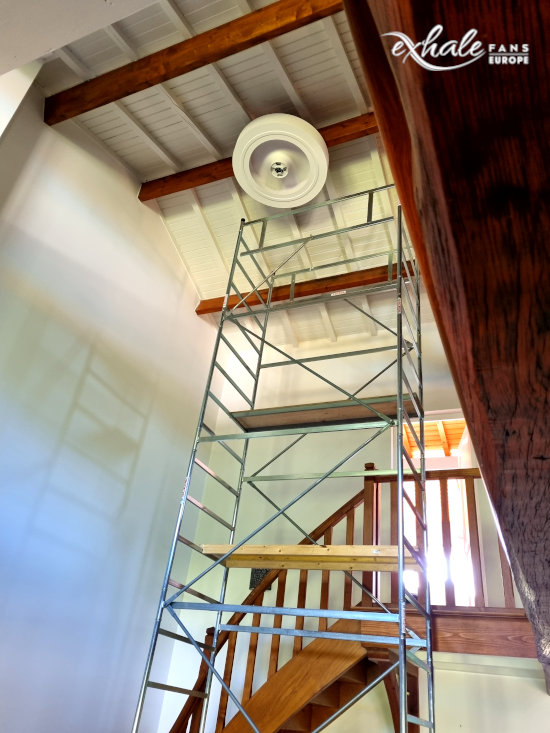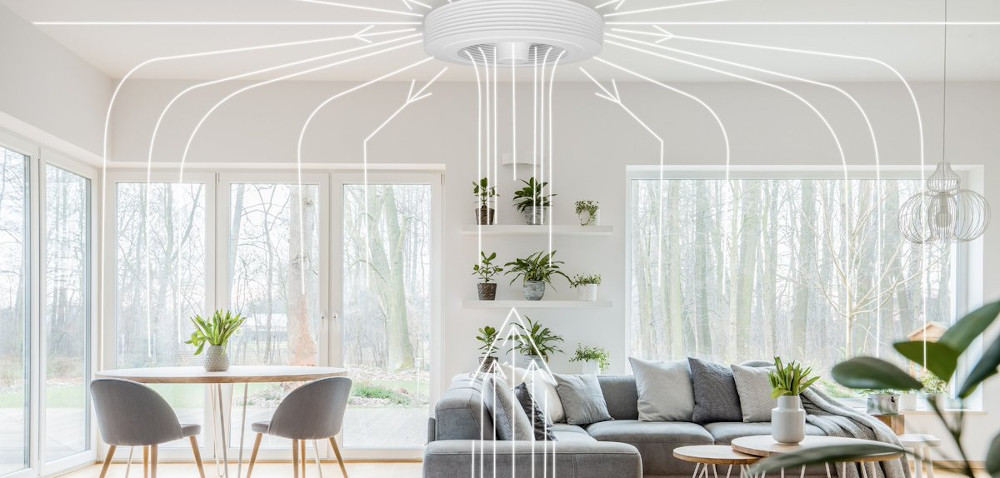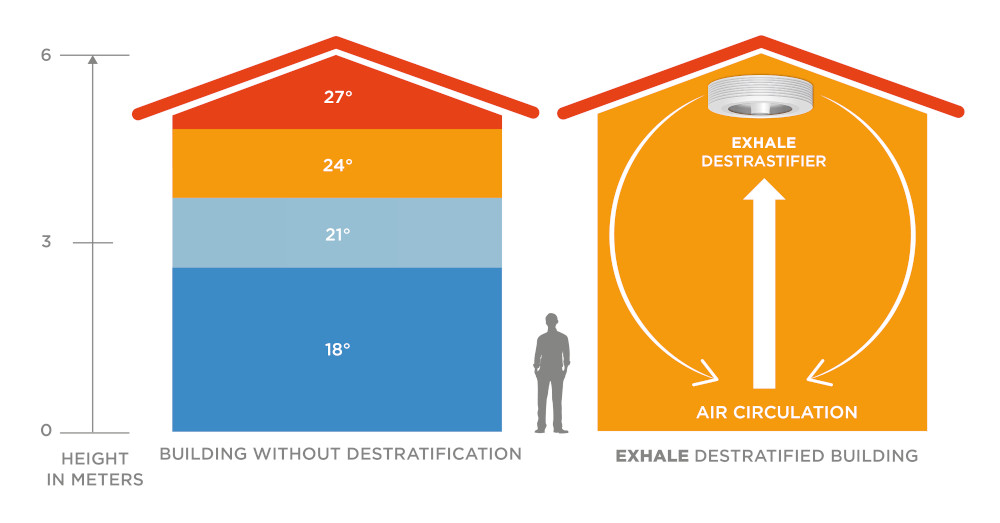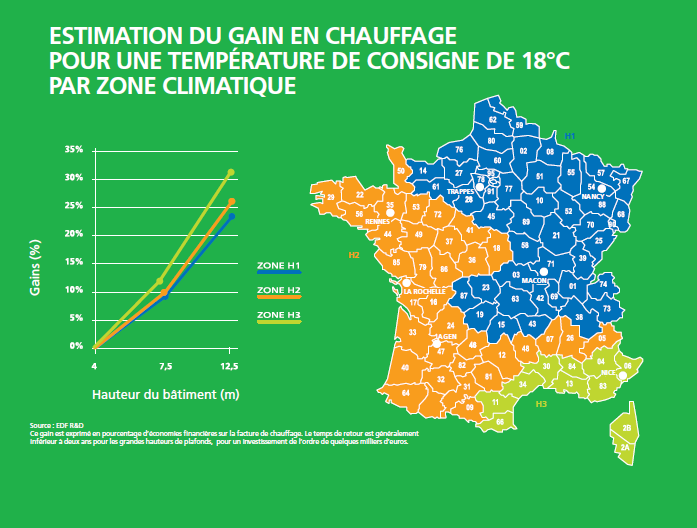Air destratification with Exhale
1. Fluid mechanics, especially in the context of air
2. The functional features of an air destratification fan
3. The practical effects of air destratification
4. The benefits of air destratification
1. Fluid mechanics, especially in the context of air
Warm air is lighter than cold air. So in a closed and unventilated room or space, warm air will tend to rise to the ceiling and stay at a high level, while the cold air will remain at floor level.
In high spaces (mezzanine levels, offices, large industrial spaces, etc.), the temperature gradient (difference) between floor and ceiling can be very significant (up to 10°C), and is proportional to the ceiling height.
The general assumption is that above the height of 4 metres in a closed and unventilated room, the spontaneous rising of hot air to the ceiling or roof results in an increase in air temperature of around 1.5°C per metre.
Diagram 1- Air stratification in a closed and unventilated room
The result of this physical effect is thermal stratification of the ambient air, which is to say that the air is divided into layers of different temperatures; lower at floor level and rising towards ceiling or roof level.
This spontaneous stratification of the ambient air in closed and unventilated spaces, whether domestic (mezzanine floor) or commercial (large industrial spaces, etc.), will have the following outcomes:
- A significant energy loss between floor level (at which the room is heated and its occupants live, work and move around) and ceiling or roof level. This loss will effectively result in the space being overheated in an attempt to maintain comfortable conditions at floor level.
- A waste of money as a result of heating the ceiling or roof unnecessarily, and overheating the space as a whole.
- Ecological mismanagement./li>
To counter this level of inconvenience and waste as a result of fluid mechanics, the construction industry has developed mechanical room air destratification techniques that continuously circulate the air, bringing hot air downwards and sending cold air upwards.
The new environnemental standards RE2020 aim to reduce the impact of new buildings on the climate and lower their energy consumption.
Exhale fans are an economical and proven way to help achieve these ambitious climate goals.
With Exhale bladeless ceiling fans, you will improve winter comfort and summer comfort while reducing energy costs.
Video illustrating how the Exhale fan circulates air throughout an enclosed space:
This way, warm air at ceiling level is continually returned to floor level using the thermal convection effect.
The mechanical room air destratification technique was first applied in business premises (large industrial spaces, workshops, warehouses, supermarkets, shopping centres, gyms, stations, museums, places of worship, amphitheatres, cinemas, etc.) before being extended to houses.
In practical terms, it is likely that air stratification actually begins at heights as low as 2.50m, which explains why air destratification fans can benefit domestic interiors.
Find out how the Exhale bladeless ceiling fan can heat your home effectively.
2. The functional characteristics of an air destratification fan
There are 4 essential parameters to consider when choosing an air destratification fan.
1 – The treated air flow rate
This refers to the volume of ambient air circulated by the destratification fan within a given period of time. This volume is calculated in terms of m3 per hour; the higher the air flow rate, the more effective the destratification.
2 – The ambient air circulation rate
This value indicates the efficiency of the air mixing system by calculating the ratio of the total treated air flow rate to the volume of the space or room. A flow/volume ratio of around 3 is considered an efficient level of air mixing.
3 – The noise generated by the fan
The level of noise generated by these fans is usually within the range 45 to 60 decibels.
The Exhale fan is exceptionally quiet thanks to its high-quality (brushless DC) motor and the fact that it has no blades (and therefore no friction between blades and air). Its emitted noise level is between 35 decibels (speed 1) and 40 decibels (speed 6).
Destratification (for winter comfort) requires a slow rotation speed (i.e. speed 1, 35 decibels and 4 Watts consumption) and more frequent operation (to provide consistent destratification).
So if you run your Exhale fan at speed 1 (35 decibels / 4 Watts) continuously (24/7) for 1 month, it will cost you less than €0.50 in electricity. The amount of energy you save (electric heating, stove, fireplace, wood pellet stove, etc.) will be far greater than that, in addition to which you will have a more comfortable environment.
More information about the Exhale fan sound level:www.exhale-europe.com/shop/en/exhale-fans/9-exhale-fan-white-with-led-3k.html
4 – The speed regulator and thermostat
CThese two components enable airflow to be finely tuned to the specific air stratification of a given room or space.
Using its remote control or 6-speed wall-mounted control, the Exhale ceiling fan generates noise levels of between 35 and 45db at an air volume circulation rate of 115 m3per minute (i.e. 6,900 m3 per hour).
3. The practical effects of air destratification
Using an air destratification fan will create a consistent temperature at every level of a room or space by continuously and completely mixing the ambient air it contains. Simply by moving warm air from ceiling level to floor level and vice versa (cold air from floor level to ceiling or roof level) improves air distribution and room temperature, thereby reducing temperature gradients or variances.

Fan installed at a height of 6 metres for destratification.
4. The benefits of air destratification
- A financial benefit, with up to 30% lower heating costs. The actual level of saving will depend on a range of factors, including the preferred temperature of the room or space concerned, its ceiling height and local climate conditions.
Source, EDF website
https://www.edf.fr/entreprises/le-mag/le-mag-entreprises/conseils-energie-competitivite/pourquoi-s-equiper-d-un-destratificateur-d-air
- An energy saving benefit: creating a consistent ambient air temperature by destratification limits heat loss through the roof. In the same way, it avoids overheating the room at floor level (as the temperature tends to rise at roof or mezzanine level).
- An ecological benefit: using destratification to mix the ambient air delivers a potential 30% reduction in heating-related CO2 emissions.
- A dehumidification benefit as a result of increasing air circulation flow rates
- A better quality of life in terms of comfort: mixing the air and creating a consistent ambient air temperature within a room or space significantly increases the comfort of its occupants
The unique operating principle of the Exhale bladeless ceiling fan makes life more comfortable in summer by reducing the perceived temperature by around 4°C (sufficient to dry perspiration from the skin) and more comfortable in winter by destratifying temperature layers to create a more consistent mix of air in the room or space (including distributing the heat emitted by a stove or fireplace right around the room).
The Exhale Bladeless Ceiling Fan is designed for both trade users and homeowners.
How much does an Exhale that runs 24 hours a day cost?
Based on a kWh cost of 0.2516€ (average rate of EDF – Electricity of France in march 2024). Knowing that an Exhale in speed 1 (minimum / for winter comfort), consumes only 4 Watts per hour. Knowing that an Exhale in speed 6 (maximum / for summer comfort) consumes 50 Watts per hour. In a month of 30 days, running 24 hours a day, it will therefore run 24 x 30 = 720h/month.
- At speed 1 (winter comfort), an exhale running 24 hours a day will consume 0,72€ of electricity per month.
- At speed 6 (summer comfort), an exhale running 24 hours a day will consume 9,05€ of electricity per month.
| Speed | Consumption (W/h) | Cost Watt/hour | Per day (€) | Per month (€) |
|---|---|---|---|---|
| 1 | 4 | 0,0002516 | 0,02415 | 0,7246 |
| 3 | 9 | 0,0002516 | 0,05434 | 1,6303 |
| 6 | 50 | 0,0002516 | 0,3019 | 9,05 |
We had a problem with heat distribution in the house, which has a mezzanine, a half-floor and a room at the back. Thanks to the fan, the heat is much more even and the differences between all areas of the house have been drastically reduced.
Installed in 2018 to circulate the warm air from a closed wood-burning fireplace. The Exhale ceiling fan provides even heat throughout the room.
The Exhale fan was installed and commissioned during the winter of 2019/2020 at a height of 4.50 m to resolve the temperature differences between the ground floor and upper floor. There was no disappointment with the product, which lived up to its promise by distributing heat evenly across the large living room-mezzanine area. No more temperature differences halfway up the staircase, no more feeling of cold at the bottom because the heat is very evenly distributed at a height of 4.50 m! A pleasant feeling of well-being.
We have a large S-shaped living room with a staircase leading to the first floor, and there were always big differences in temperature between the different areas. Now the heat is well distributed, and the proof is that it’s no hotter at the top of the stairs than at the bottom, and that’s only after 10 minutes of operation.
Mezzanine open and big problem of distribution of heating between the top and the bottom in winter and big heat in summer on the floor, the fan has completely solved the problem.





